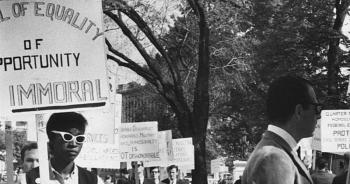Different fight, 'same goal': How the Black freedom movement inspired early gay activists
On April 25, 1965, three teenagers refused to leave Dewey’s Restaurant in Philadelphia after employees repeatedly denied service to “homosexuals and persons wearing nonconformist clothing,” according to Drum magazine, which was created by the Janus Society, an early gay rights group.
The teens were arrested and charged with disorderly conduct, and Janus Society members protested outside of the restaurant for the next five days, according to Marc Stein, a history professor at San Francisco State University.
“Unlike so many other episodes, it kind of combined issues of homosexuality and trans issues,” Stein, author of “Rethinking the Gay and Lesbian Movement,” told NBC News.
On May 2, three more people staged a second sit-in at Dewey’s. Though the restaurant called the police, the protesters weren’t arrested, and after a few hours they left voluntarily, according to a Janus Society newsletter. The Society wrote that the protests and sit-ins were successful in preventing future denials of service and arrests.
The sit-in at Dewey’s is among a long list of examples that show a “direct line” to the Black civil rights movement, according to Stein. Specifically, sit-ins organized by gay activists in the ‘60s appear to be directly inspired by protests held in 1960 by Black college students at Woolworth’s lunch counter in Greensboro, North Carolina, against racial segregation.
Early LGBTQ activists (though they didn’t use that acronym at the time) adopted many of the civil rights movement’s strategies, Stein said, and they relied on much of the foundation laid by Black civil rights activists.
But the two movements weren’t necessarily separate — they often overlapped — and so influence happened in a few ways, Stein said.
“Influence can be the influence of ideas, and specifically, ideologies, influence of strategies,” he said. “Influence can also come in the form of people who move between movements, or who are engaged in multiple movements, and we do have examples of that in the early LGBT movement.”
The influence — or ‘plagiarism’ — of ideas
Queer activists were building a movement long before the 1969 Stonewall uprising in New York City, which is widely referred to as a turning point in the LGBTQ rights movement. Though Stonewall was a pivotal moment, activists like Frank Kameny were organizing for gay rights well before.
Kameny co-founded the Mattachine Society in Washington, D.C., one of the first homophile groups ("homophile" being the adjective of choice at the time), and he drew strategies directly from the Black civil rights movement, according to Eric Cervini, a historian and author of “The Deviant’s War,” which focuses on Kameny and the early gay rights movement.
“Every single element of what we know of as Pride and gay rights and, especially, the pre-Stonewall homophile movement, was borrowed from the Black Freedom Movement,” Cervini said. “Frank Kameny’s primary role, what made him so brilliant but also complex of a historical figure, was that he served primarily as a Xerox machine copying different elements of the Black Freedom Movement and applying that to a previously nonmilitant, nonprotesting movement.”




